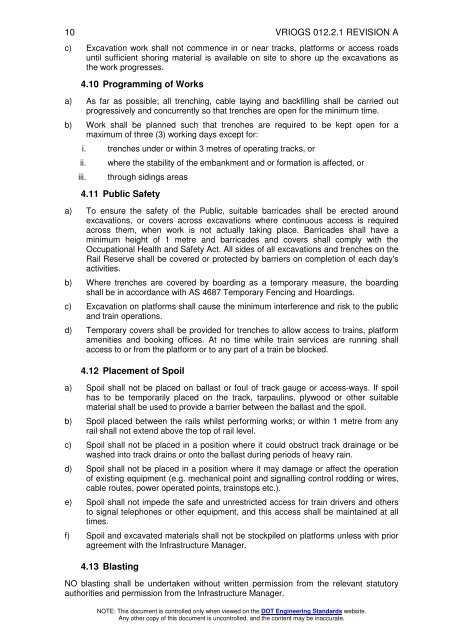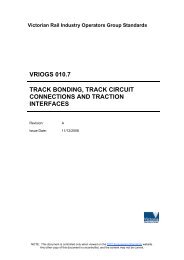VRIOGS 012.2.1 - Public Transport Victoria
VRIOGS 012.2.1 - Public Transport Victoria
VRIOGS 012.2.1 - Public Transport Victoria
Create successful ePaper yourself
Turn your PDF publications into a flip-book with our unique Google optimized e-Paper software.
10 <strong>VRIOGS</strong> <strong>012.2.1</strong> REVISION A<br />
c) Excavation work shall not commence in or near tracks, platforms or access roads<br />
until sufficient shoring material is available on site to shore up the excavations as<br />
the work progresses.<br />
4.10 Programming of Works<br />
a) As far as possible; all trenching, cable laying and backfilling shall be carried out<br />
progressively and concurrently so that trenches are open for the minimum time.<br />
b) Work shall be planned such that trenches are required to be kept open for a<br />
maximum of three (3) working days except for:<br />
i. trenches under or within 3 metres of operating tracks, or<br />
ii.<br />
iii.<br />
where the stability of the embankment and or formation is affected, or<br />
through sidings areas<br />
4.11 <strong>Public</strong> Safety<br />
a) To ensure the safety of the <strong>Public</strong>, suitable barricades shall be erected around<br />
excavations, or covers across excavations where continuous access is required<br />
across them, when work is not actually taking place. Barricades shall have a<br />
minimum height of 1 metre and barricades and covers shall comply with the<br />
Occupational Health and Safety Act. All sides of all excavations and trenches on the<br />
Rail Reserve shall be covered or protected by barriers on completion of each day's<br />
activities.<br />
b) Where trenches are covered by boarding as a temporary measure, the boarding<br />
shall be in accordance with AS 4687 Temporary Fencing and Hoardings.<br />
c) Excavation on platforms shall cause the minimum interference and risk to the public<br />
and train operations.<br />
d) Temporary covers shall be provided for trenches to allow access to trains, platform<br />
amenities and booking offices. At no time while train services are running shall<br />
access to or from the platform or to any part of a train be blocked.<br />
4.12 Placement of Spoil<br />
a) Spoil shall not be placed on ballast or foul of track gauge or access-ways. If spoil<br />
has to be temporarily placed on the track, tarpaulins, plywood or other suitable<br />
material shall be used to provide a barrier between the ballast and the spoil.<br />
b) Spoil placed between the rails whilst performing works; or within 1 metre from any<br />
rail shall not extend above the top of rail level.<br />
c) Spoil shall not be placed in a position where it could obstruct track drainage or be<br />
washed into track drains or onto the ballast during periods of heavy rain.<br />
d) Spoil shall not be placed in a position where it may damage or affect the operation<br />
of existing equipment (e.g. mechanical point and signalling control rodding or wires,<br />
cable routes, power operated points, trainstops etc.).<br />
e) Spoil shall not impede the safe and unrestricted access for train drivers and others<br />
to signal telephones or other equipment, and this access shall be maintained at all<br />
times.<br />
f) Spoil and excavated materials shall not be stockpiled on platforms unless with prior<br />
agreement with the Infrastructure Manager.<br />
4.13 Blasting<br />
NO blasting shall be undertaken without written permission from the relevant statutory<br />
authorities and permission from the Infrastructure Manager.<br />
NOTE: This document is controlled only when viewed on the DOT Engineering Standards website.<br />
Any other copy of this document is uncontrolled, and the content may be inaccurate.

















